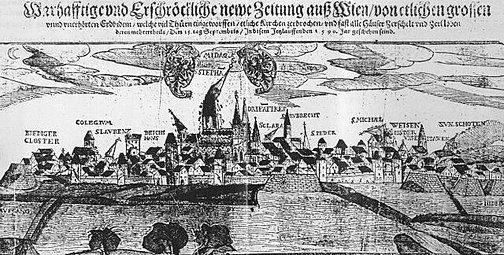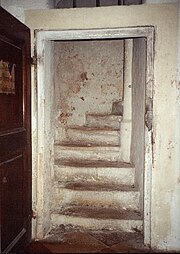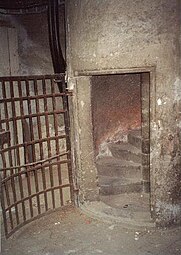Antonius Gardesoni
Antonius Gardesoni was an Italian master stonemason and sculptor of the Renaissance .
His letter of March 22, 1590 to the abbot of Heiligenkreuz Abbey was considered the oldest Kaisersteinbruch document for centuries . This dates from June 13, 1576 and documents stone deliveries from the quarry on Leithaberg for the construction of Castle Neugebauten .
Live and act
In 1551 a quarry on Leithaberg was put back into operation, which had been anchored in the consciousness of experts since ancient times. The first stonemasons to work here again were Antonius Gardesoni, an Italian journeyman , born in Como, and Pietro Solari , a Swiss sculptor from Bissone. Before that he worked in Wiener Neustadt , a main shop for the stonemasonry and bricklaying trade, and had been commissioned to design a basin from the white, very hard stone, the Schweizerhofbrunnen, for the tube fountain in the innermost core of the Vienna Hofburg.
Stallburg of the Vienna Hofburg
On behalf of Emperor Ferdinand I , the Renaissance palace around the square arcaded courtyard was converted into court stables from 1558 to 1562, under the direction of Hans Saphoy , master builder of St. Stephen, with his brothers Antonius and Pietro Solari and Antonius Gardesoni.
New building
Emperor Maximilian II allowed himself to be captured by the spirit of antiquity, and near Vienna he had the Neugebude Castle, the most important Renaissance building in his sphere of influence, built. As in Italy it should consist of white marble stone, so the stone found here received the name Kaiserstein from the beginning, and the quarry on Leithaberg became Her Imperial Majesty's quarry in 1579, or the imperial quarry on Leithaberg for short .
The oldest stonemason on the Leithaberg
From the letter to Abbot Johannes Rueff , in extracts ... I - Master Antonius Gardesoni - as the oldest stonemason on the Leithaberg can say that I worked here in the quarry on Leithaberg for a long time and that I have now reached a special age. So that I may entertain my wife and children better in the future, my obedient request reaches Your Grace. Since I worked for thirty years here have, look for a new quarry and may work in it.
Helix stairs of the Michaelerkirche
Michaelerkirche , end of the 1st spiral staircase that leads into the tower, all hard stone
1590 earthquake
Due to an earthquake on 15./16. September 1590 (Epicenter Neulengbach, Lower Austria.) St. Stephen's Cathedral , Michaelerkirche (collapse of the tower crown), Jesuit and Schottenkirche were badly damaged. Account books and files give evidence of the damage and the effort involved in removing it. ... almost a man's large stones fell from the Stephansturm and a portal above a church door was broken through and shattered. A large stone lion has also fallen and the tower almost bent and battered ... at St. Michael it threw the church tower and the iron bars in half and otherwise did great damage to the church ..... The earthquake and its horror was soon replaced by other “divine punishments”, the Turkish war that began again in 1592, as the portent of which it was repeatedly assessed by later commentators. And the reconstruction offered the possibility of redesigning some buildings in the newest taste. So the tower of St. Michael got a new look.
The damage to the Michaelerkirche was documented by the geologist Alois Kieslinger , TU-Vienna.
Sources and literature
- Lower Austria State Archives : State files B. 9/24 .
- Harald Prickler : On the history of Kaisersteinbruch. Burgenland State Archives , 1961.
- Documents from the 16th century in the imperial quarry on Leithaberg, Antonius Gardesoni. In: Helmuth Furch , communications from the Kaisersteinbruch Museum and Culture Association. No. 27, 1993, pp. 10-11.
- Harald Prickler: The Komasken - Italian artists in Burgenland. In: Messages from the Kaisersteinbruch Museum and Culture Association . No. 36, 1995, ZDB -ID 2926687-7 , pp. 5-9.
- Harald Prickler: Kaisersteinbruch - From the history of an Italian artist colony. Burgenland State Archives, 1998.
- Helmuth Furch: Historical Lexicon Kaisersteinbruch. 2 volumes. Museum and Culture Association, Kaisersteinbruch 2002–2004, ISBN 978-3-9504555-8-8 .
Individual evidence
- ↑ Heiligenkreuz Abbey Archive: Letter of March 22, 1590, register
- ↑ Hofkammerarchiv, Niederösterreichische Herrschaftsakten June 13, 1576.
- ↑ Hofkammerarchiv, Niederösterreichische Herrschaftsakten April 4, 1579, for the first time Her Majesty's Quarry at Leithaberg .
- ^ Heinrich Berg: The earthquake of 1590. In: Wiener Geschichtsblätter . Vol. 45, No. 3, 1990, pp. 166-171.
- ↑ Alois Kieslinger : The building of St. Michael in Vienna and its history. In: Yearbook of the Association for the History of the City of Vienna . Vol. 10, 1952/1953, ISSN 1011-4726 , pp. 1-74, (also as a special print). From the sacrificial cow collection
| personal data | |
|---|---|
| SURNAME | Gardesoni, Antonius |
| BRIEF DESCRIPTION | Italian master stonemason of the Renaissance |
| DATE OF BIRTH | before 1550 |
| DATE OF DEATH | after March 22, 1590 |







